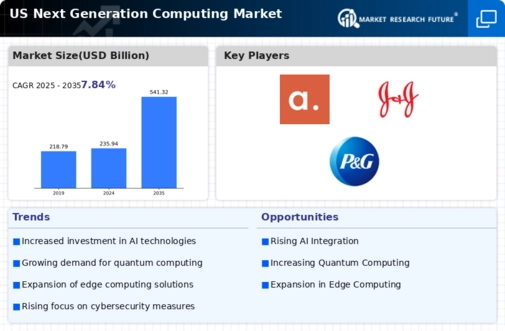Integration of Edge Computing
The integration of edge computing is emerging as a pivotal driver in the next generation-computing market. By processing data closer to the source, edge computing reduces latency and bandwidth usage, which is particularly beneficial for applications requiring real-time responses, such as IoT devices and autonomous systems. In 2025, the edge computing market is projected to grow at a CAGR of 30%, reflecting the increasing adoption of smart devices and the need for efficient data management. This trend is likely to compel organizations to invest in edge computing solutions, which may account for up to 25% of their overall IT expenditures. As a result, the next generation-computing market is poised to evolve, with edge computing becoming a fundamental component of modern computing architectures.
Surge in Data Processing Needs
The next generation-computing market is experiencing a surge in demand for advanced data processing capabilities. As organizations increasingly rely on data-driven decision-making, the need for faster and more efficient computing solutions becomes paramount. In 2025, it is estimated that data generation will reach 175 zettabytes, necessitating robust computing infrastructures. This trend is likely to drive investments in high-performance computing systems, which are essential for processing vast amounts of data in real-time. Consequently, companies are expected to allocate significant portions of their IT budgets, potentially exceeding 30%, towards upgrading their computing capabilities. This shift not only enhances operational efficiency but also positions businesses to leverage insights from big data analytics, thereby fostering innovation within the next generation-computing market.
Growth of Hybrid Cloud Solutions
The growth of hybrid cloud solutions is significantly influencing the next generation-computing market. Organizations are increasingly adopting hybrid cloud models to balance the benefits of public and private clouds, allowing for greater flexibility and scalability. In 2025, the hybrid cloud market is expected to reach $100 billion, driven by the need for secure and efficient data management. This trend is likely to encourage businesses to invest in cloud computing technologies, which may represent up to 35% of their IT budgets. The ability to seamlessly integrate on-premises infrastructure with cloud services enables organizations to optimize their computing resources, thereby enhancing agility and responsiveness in a rapidly changing business environment. Consequently, hybrid cloud solutions are becoming a cornerstone of the next generation-computing market.
Demand for Enhanced Energy Efficiency
The next generation-computing market is witnessing a growing emphasis on energy efficiency as organizations strive to reduce operational costs and environmental impact. With energy consumption in data centers projected to account for 3% of global electricity use by 2025, there is a pressing need for more sustainable computing solutions. Companies are increasingly investing in energy-efficient hardware and software, which could lead to a reduction in energy costs by up to 40%. This focus on sustainability not only aligns with corporate social responsibility goals but also enhances the competitiveness of businesses within the next generation-computing market. As a result, energy-efficient technologies are likely to become a key differentiator for companies seeking to optimize their computing resources.
Advancements in Machine Learning Algorithms
Advancements in machine learning algorithms are playing a crucial role in shaping the next generation-computing market. As organizations seek to harness the power of artificial intelligence, the demand for sophisticated machine learning techniques is on the rise. In 2025, the machine learning market is projected to grow to $20 billion, reflecting the increasing reliance on AI-driven solutions across various industries. This growth is likely to spur investments in computing infrastructure capable of supporting complex algorithms, which may account for up to 30% of IT spending. The ability to analyze large datasets and derive actionable insights is becoming essential for maintaining a competitive edge, thereby driving innovation within the next generation-computing market.














Leave a Comment